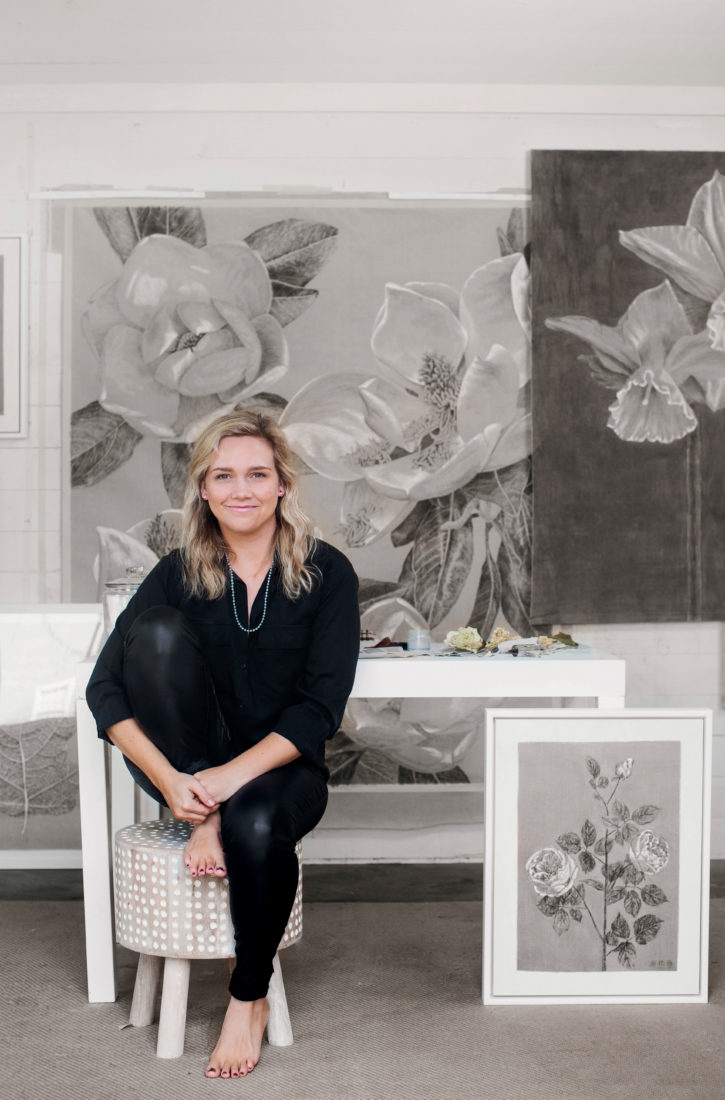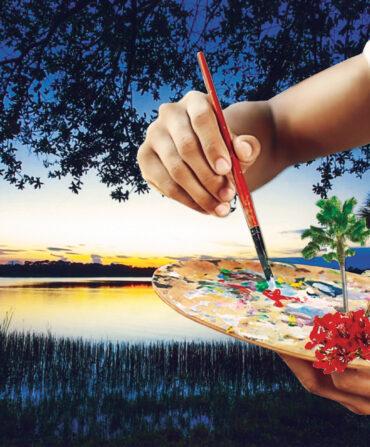Cheerful zinnias and tall papery cosmos, petite sunflowers and delicate white dill dot the fence line leading from the house the artist Emily Morgan Brown shares with her husband and three young daughters to her backyard studio in Birmingham, Alabama. Nearby, blueberry bushes flank rows of strawberry plants. There’s a fig tree that will be heavy with fruit come July. And a vegetable garden yields the likes of heirloom tomatoes, okra, and mint. “My girls love watching the bugs, too,” Brown says. “We lift rocks and spy on roly-polies, ladybugs, and caterpillars.” All of it—bloom to bug—serves as inspiration for Brown, who picked up her first sketch pad as a child and began searching for subjects in her surroundings. “I was always drawing my teachers when I was supposed to be taking notes,” she says. She sold her first commissioned portrait before she graduated from high school. But it would take a “practical” degree in graphic design, a stint at an ad agency, and dozens more portraits before she realized her artistic destiny was growing right outside her studio window.
Feeling less fulfilled by portraiture, Brown had begun brushing up on art history when she discovered gray scale, or grisaille—a painting technique popularized during the early Renaissance when the demand for marble relief sculpture reemerged. Drawings inked on linen tapestries rendered in shades of gray were hung on walls and ceilings to give the illusion of sculpture, at a much lower cost. The concept provided the spark Brown needed. But her discovery of egg tempera turned flicker to flame. An all-natural mixture typically made of egg yolk, pigment, and water, egg tempera was the medium of choice for artists before the introduction of oil paint in the fifteenth century, and the paint traditionally used for grisaille. “Suddenly buying tubes of bright artificial colors felt consumerist,” Brown says. “Materials and how they are made became as important to me as the subject matter.”
Around the time she was teaching herself this ancient technique with YouTube, she began a side project photographing flowers. “I was leaving the blooms in my studio in vases…dead,” Brown says. “I felt so bad about throwing them away that I would have my husband do it. I had this strangely intense connection to them.” So rather than discarding the flowers, Brown decided to press them into service, grinding them to powder and mixing them into her egg tempera. Using charcoal, white gesso, and the tempera, Brown brought the blooms back to life on large unframed swaths of fine gray Belgian linen. Achieving grisaille’s three-dimensional effect is a painstaking process—every mark made on the linen is permanent.
While black and white might seem an unlikely choice for botanical paintings, “I wanted to take a different approach and focus on their form,” Brown says, “which is what I love most about them.” Whatever is blooming in her garden or others around town informs the paintings—and the paint, which she makes from scratch for every new piece. Her depictions of ripe figs plucked from the tree she walks by on the way to her studio are some of her most popular. But magnolias are a personal favorite. “My grandmother had a huge magnolia tree in her yard, and I swear I can smell it while I’m drawing,” Brown says. She recently completed a six-foot-by-five-foot magnolia for a client. And she’s produced works as large as nine by nine. “My pieces are intended to hang as tapestries. They don’t have the same presence if they’re smaller. Drawn so much larger than life, they’re almost regal.”








